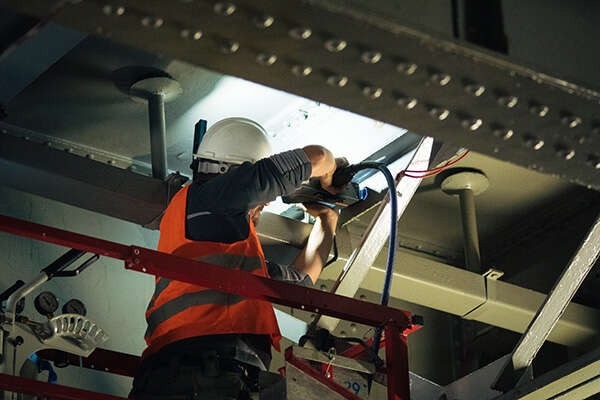When measuring historic steels in structures such as bridges, it can be hard to obtain appropriate steel input values for component safety calculations. Often, destructive testing is used, where a sample is extracted from a structure, causing damage that inevitably needs to be repaired. This can also be extremely time-consuming and expensive.

Image Credit: Hitachi High-Tech Analytical Science
The German engineering consulting company IWT Solutions AG turned to Hitachi’s PMI-MASTER Smart portable spark OES analyzer for non-destructive on-site elemental analysis to complete the steel input calculations needed to measure the old, historic steels at the Berlin East train station and produce new guidelines for component safety in the German construction industry.
Measuring Old Historic Steels
Built in the 19th century, Berlin East Station is made up of a lot of historic old steels. Initial investigations revealed that different steels were used – in this case, puddle steel and mild steel – which fundamentally are comprised of different chemical compositions, and thus, have a bearing on component safety and why PMI inspection is crucial.
IWT Solutions AG has been working in collaboration with Professor Bertram Kühn from the Department of Steel, Composite and Timber Construction at the Technische Hochschule Mittelhessen to evaluate component safety and develop a new method that will make the process of measuring material properties easier, faster, and much more efficient.
With the support of Deutche Bahn AG (German Rail), the team extracted a total of thirty drill cores for initial analysis in the laboratory. They also tested the composition of the coatings and how deep to grind to determine chemical composition.
Taking Metal Analysis from the Laboratory to On-Site
Until recently, only laboratory-based equipment was utilized to generate the compositional metal analysis to deliver the values needed for calculations. The team was aware that using OES has its strengths in the laboratory. However, on-site, the team encountered very different conditions. That is why a portable OES was selected to identify the chemical composition of the bridge structure.
X-Ray fluorescence (XRF) analysis was also taken into consideration. Portable XRF is easy-to-use, but OES was ultimately chosen as measuring carbon is an integral component of the measuring task, which XRF instruments cannot do.
The team at IWT Solutions AG visited Hitachi’s German application center for in-house investigations. This opened up the opportunity for additional testing with the PMI-MASTER Smart to establish whether the fundamental elements could also be determined by mobile spark OES.
As the test results met IWT Solution AG’s standards, the portable metals analyzer was ready to be taken on-site.
Hitachi’s experts went along with IWT Solutions AG to see how to modify what was carried out in the laboratory on-site.
Peter Langenberg, owner and CEO of IWT Solutions AG, stated, “We hope to learn a lot more about the bridge and faster, as taking samples how we used to would limit our sample numbers. We expect with the PMI-MASTER Smart to take 100 or 200 measurements in relatively short time.”
Elements that Matter for Steel Analysis
The chemical elements of interest throughout the project were those typically used for structural steel, such as carbon, manganese, phosphorus, silicon, and sulfur. In the initial investigations, the team discovered that phosphorous was a key element to help identify the differences between steels, specifically between puddle steel and mild steel.
With phosphorus being detrimental for steel composition and not easy to measure, the team learned that using Hitachi’s UVTouch probe, it was relatively straightforward to measure phosphorus and sulfur.
Developing New Guidelines for the Construction Industry
The construction industry is heavily dependent on standards and guidelines, and Deutsche Bahn AG has a number of internal guidelines in addition to the well-established standards. The recalculation guideline 805 specifically applies to old steel and to old structures.
Peter Langenberg, owner and CEO of IWT Solutions AG, explained, “If this test is successful, we hope to include this process in the recalculation guideline as a minimally invasive measurement method and provide a broad group of users with the possibility of applying this process. Our next steps are to see if everything works out as planned. So far it looks very positive.”
The plan is to convert this into a guideline that highlights how to apply the process safely, handing out specifications for third parties who use this process so that they are aware of what to do without having to repeat the developments. Thus, with the guidelines, they know precisely what to do to obtain a safe result. After all, the result will have a bearing on component safety and structure.
Customer Service
The team from IWT Solutions AG not only encountered an extremely compact, portable instrument from Hitachi but was also given high levels of support throughout the project. First during the trial measurements phase and also during the on-site measurement stage that was conducted in Berlin.
Good support to us means that while we have defined the measurement task, we don’t fully understand how the instrument works, so when there are specific issues we have experts ready to help us. They are able to tell us how we can best adjust the analyzer for the task. This way we can combine using the analyzer and taking the measurement correctly.
Peter Langenberg, Owner and CEO, IWT Solutions AG
“Having spent two days measuring with the analyzer, and of course I received a good introduction at Hitachi’s application center, my team and I have found that we were able to operate the PMI-MASTER Smart relatively quickly on our own. We understood the display, how to set-up the instrument, and all the functions are self-explanatory. I must compliment the device; it’s very well built,” Langenberg added.
Discover more about how Hitachi’s different solutions could help with PMI safety inspection or component safety analysis. Contact Hitachi experts today for a demo.

This information has been sourced, reviewed and adapted from materials provided by Hitachi High-Tech Analytical Science.
For more information on this source, please visit Hitachi High-Tech Analytical Science.